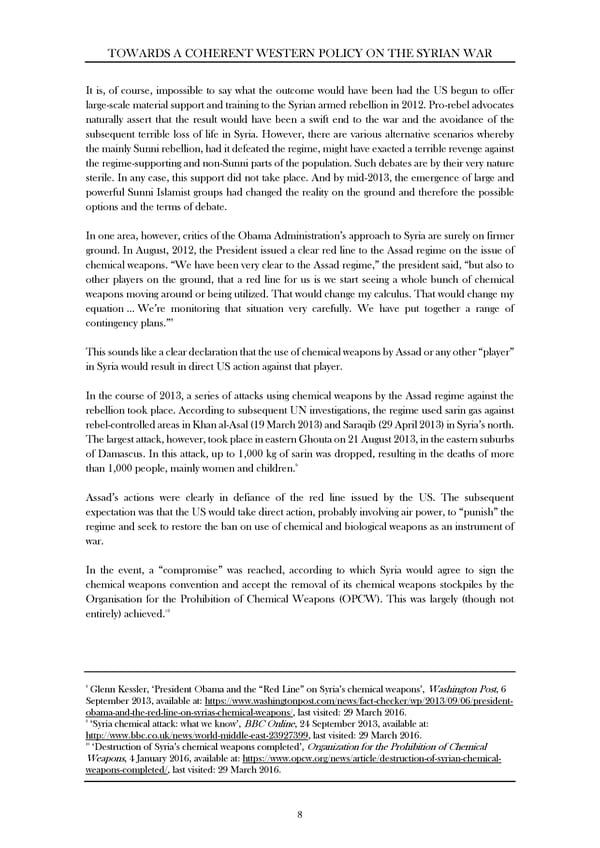TOWARDS A COHERENT WESTERN POLICY ON THE SYRIAN WAR It is, of course, impossible to say what the outcome would have been had the US begun to offer large-scale material support and training to the Syrian armed rebellion in 2012. Pro-rebel advocates naturally assert that the result would have been a swift end to the war and the avoidance of the subsequent terrible loss of life in Syria. However, there are various alternative scenarios whereby the mainly Sunni rebellion, had it defeated the regime, might have exacted a terrible revenge against the regime-supporting and non-Sunni parts of the population. Such debates are by their very nature sterile. In any case, this support did not take place. And by mid-2013, the emergence of large and powerful Sunni Islamist groups had changed the reality on the ground and therefore the possible options and the terms of debate. In one area, however, critics of the Obama Administration’s approach to Syria are surely on firmer ground. In August, 2012, the President issued a clear red line to the Assad regime on the issue of chemical weapons. “We have been very clear to the Assad regime,” the president said, “but also to other players on the ground, that a red line for us is we start seeing a whole bunch of chemical weapons moving around or being utilized. That would change my calculus. That would change my equation … We’re monitoring that situation very carefully. We have put together a range of 8 contingency plans.” This sounds like a clear declaration that the use of chemical weapons by Assad or any other “player” in Syria would result in direct US action against that player. In the course of 2013, a series of attacks using chemical weapons by the Assad regime against the rebellion took place. According to subsequent UN investigations, the regime used sarin gas against rebel-controlled areas in Khan al-Asal (19 March 2013) and Saraqib (29 April 2013) in Syria’s north. The largest attack, however, took place in eastern Ghouta on 21 August 2013, in the eastern suburbs of Damascus. In this attack, up to 1,000 kg of sarin was dropped, resulting in the deaths of more 9 than 1,000 people, mainly women and children. Assad’s actions were clearly in defiance of the red line issued by the US. The subsequent expectation was that the US would take direct action, probably involving air power, to “punish” the regime and seek to restore the ban on use of chemical and biological weapons as an instrument of war. In the event, a “compromise” was reached, according to which Syria would agree to sign the chemical weapons convention and accept the removal of its chemical weapons stockpiles by the Organisation for the Prohibition of Chemical Weapons (OPCW). This was largely (though not 10 entirely) achieved. 8 Glenn Kessler, ‘President Obama and the “Red Line” on Syria’s chemical weapons’, Washington Post, 6 September 2013, available at: https://www.washingtonpost.com/news/fact-checker/wp/2013/09/06/president- obama-and-the-red-line-on-syrias-chemical-weapons/, last visited: 29 March 2016. 9 ‘Syria chemical attack: what we know’, BBC Online, 24 September 2013, available at: http://www.bbc.co.uk/news/world-middle-east-23927399, last visited: 29 March 2016. 10 ‘Destruction of Syria’s chemical weapons completed’, Organization for the Prohibition of Chemical Weapons, 4 January 2016, available at: https://www.opcw.org/news/article/destruction-of-syrian-chemical- weapons-completed/, last visited: 29 March 2016. 8
 Towards A Coherent Policy On The Syrian War Page 9 Page 11
Towards A Coherent Policy On The Syrian War Page 9 Page 11